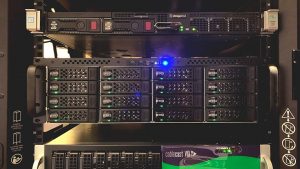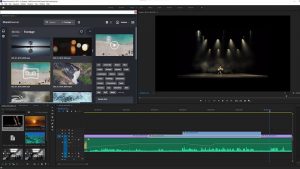Studio Network Solutions’ EVO Modernizes Storage, LTO Archive for Grand Rapids Community College
Story Highlights
Grand Rapids Community College (GRCC) doesn’t look like many of the community colleges you’re used to. Their diverse student body occupies a large urban campus in the heart of downtown Grand Rapids, Michigan. Students choose between academic programs like architecture, culinary arts, mathematics, and manufacturing, with many more options available to kickstart their career or post-secondary education.
 GRCC has relied on their video production department for over 40 years to provide technology support for instructors and students, enhance learning with programs and lecture series, produce marketing and instructional videos for school administration, and run two cable access channels: one for higher education and the other for K-12 schools. With decades of rich archival footage and a highly-skilled video production department, this school’s media team is always immersed in their work.
GRCC has relied on their video production department for over 40 years to provide technology support for instructors and students, enhance learning with programs and lecture series, produce marketing and instructional videos for school administration, and run two cable access channels: one for higher education and the other for K-12 schools. With decades of rich archival footage and a highly-skilled video production department, this school’s media team is always immersed in their work.
So much media has to be reigned in somehow, which is exactly why Grand Rapids Community College decided to reinvent the way they store and archive their media.
Long-Term LTO, A Long Time Coming
GRCC housed their vast and valuable video archive across “walls of tape” in a closet in their video production facility for many years. In the late 2000s, they switched to digital and started storing archived content on spinning disks. After one-too-many disk failures, it was time for a new video archival strategy.
“It’s a big deal to lose 500GB of content when one of those disks failed,” says Noah DeSmit, Video Production Coordinator at Grand Rapids Community College. “We’re so used to having everything we’ve ever shot at our disposal. We knew we needed to rethink the way we kept our media secure.”
When the academic institution invested in a longer-lasting, more centralized archival system with StorageDNA, another issue still persisted in their workflow. Their aging Avid Nexis and Avid ISIS servers offered no integration with their LTO archive solution, leaving their video editors burdened with an inefficient online and archive storage workflow.
DeSmit started searching for Avid ISIS and Avid Nexis alternatives that both enhanced his tape archiving experience with StorageDNA and supported his team’s video editing workflow.
A+ Storage and Archival Solution
 “We needed three things: kick-ass storage, proxy generation, and a StorageDNA integration,” says DeSmit. “That’s what led us to EVO.”
“We needed three things: kick-ass storage, proxy generation, and a StorageDNA integration,” says DeSmit. “That’s what led us to EVO.”
Their A+ solution was none other than an EVO 16 Bay shared storage server. EVO includes the powerful and easy-to-use ShareBrowser media asset manager that integrates seamlessly with StorageDNA, plus the built-in Slingshot automations engine that generates proxy files on a recurring schedule set by the user. And yeah, it’s pretty kick-ass.
“I love all the customizable features EVO offers,” said DeSmit. “I really like that you can schedule when Slingshot indexes the server and works on proxy generation.”
“The ShareBrowser integration with StorageDNA works great,” he continued. “Our old footage is easily searchable in ShareBrowser. We preview the proxy files, find the exact clip we need, restore it, and bring it into our projects without hassle.”
This fully-optimized educational video production workflow relies heavily on EVO’s included suite of software tools—the brains behind the brawn. After all, a smart school like GRCC needs a smart server, too.
“We needed three things: kick-ass storage, proxy generation, and a StorageDNA integration. That’s what led us to EVO”
-Noah DeSmit, Video Production Coordinator at Grand Rapids Community College
Proxy Generation for Previewing Media
 Why was proxy generation so crucial to DeSmit’s video storage decision? Without a proxy file to preview, it was near impossible to find archived footage without restoring an entire project. And if the clip they wanted wasn’t there, they would have to restore yet another project from the archive and hope they had guessed correctly this time around.
Why was proxy generation so crucial to DeSmit’s video storage decision? Without a proxy file to preview, it was near impossible to find archived footage without restoring an entire project. And if the clip they wanted wasn’t there, they would have to restore yet another project from the archive and hope they had guessed correctly this time around.
Proxy generation allows for lightweight preview files to exist in the asset management system so editors can easily find and preview specific clips before restoring a project from the LTO archive. Because EVO includes this feature, GRCC is able to transcode proxies without dedicating a separate piece of hardware to the task.
EVO’s built-in transcoder can be scheduled to create proxy files of online and archived footage at recurring intervals. GRCC chooses to generate their proxies outside of office hours so they have EVO’s full bandwidth for other tasks while school is in session.
These proxy video files are perfect for previewing their media, whether it lives on their EVO video server, an older legacy server, or on a shelf in the archive closet. In other words, EVO’s automatic proxy generation gives GRCC insight into their archive that didn’t exist before.
Masters of Media Management
Enabling access to decades of past media is fantastic, but all that media can be a chore for editors to search through without a capable media asset management system to keep it organized. ShareBrowser—EVO’s included media asset manager—helps users catalog, tag, comment, and share their media with authorized users, whether that be students, faculty, the video department, or others.
With their online and archive storage systems integrated, DeSmit’s team can preview decades of archived footage in the ShareBrowser asset management system, archive media to StorageDNA directly from ShareBrower, and even restore archived media directly from the ShareBrowser interface. The added ability to restore one or two clips—rather than a full project—from the archive was another major improvement for GRCC’s archiving and editing workflow.
DeSmit provided an example use case of the EVO shared storage and StorageDNA archive integration for education. “If a building on campus is being rededicated, the video team may want to produce a retrospective on the full history of that building, including clips of its original construction. With ShareBrowser, we could just search that building’s name and get all of the clips across decades’ worth of archived projects, preview them to see which clips we want to use, and then restore only the files we need for the video.”
To put it simply, GRCC’s 40-year archive is more accessible—and therefore, more useful—with ShareBrowser and StorageDNA.
Standing the Test of Time
 Working with 4K Sony MXF for contemporary projects and managing LTO tape libraries full of various file formats was a burden on their old media storage infrastructure. That’s no longer the case for their production team.
Working with 4K Sony MXF for contemporary projects and managing LTO tape libraries full of various file formats was a burden on their old media storage infrastructure. That’s no longer the case for their production team.
“We work with all different kinds of files and codecs, and EVO handles it no problem,” said DeSmit. “Working with 4K footage, adding color correction, and compositing in Adobe After Effects is never an issue. EVO handles the hard work for us.”
In addition to changing up their codecs, GRCC uses multiple video editing software and creative applications as well. Using the ShareBrowser panel for Adobe Premiere Pro, DeSmit’s video editors can search through their entire media library—including their StorageDNA archives—without leaving Premiere Pro. And since EVO works with a variety of NLEs and creative applications, DeSmit’s video editing workflow remains smooth whether his team is cutting video on Premiere Pro or Avid Media Composer, animating in After Effects, or mixing music with Ableton Live.
Smarter Archive Solutions
The video department does a lot to serve the students, faculty, and staff at Grand Rapids Community College. All of their hard work creates a need for quality storage hardware, capable media archiving, and worthy software tools that can bridge the gap between the two.
With EVO shared storage, GRCC has found a simple and elegant solution for all of their future projects. The overall experience has been very positive for DeSmit, who worked alongside SNS support to perfect his department’s workflow.
“The support has been really great. They helped us fix any issues with our production workflows, even through the pandemic,” said DeSmit. “They are not just knowledgeable about fixing everything we need, but organized about when and how it would happen.”
With their EVO and StorageDNA workflow right where they want it, DeSmit is ready to keep building onto their amazing archive of campus footage, marketing, and broadcast television content. Looking toward that bright future, DeSmit added, “EVO gives GRCC the tools we need to make the next 40 years as impressive as the last.”
